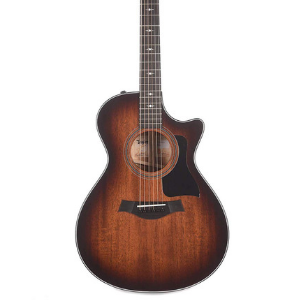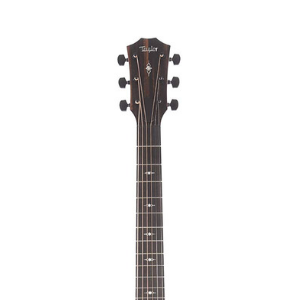- Home
- Instruments
- Gear
- Recording
- Lessons
- Reviews
- Blog


| Body And Neck: |  |
| Electronics: |  |
| Hardware: |  |
| Sound: |  |
| Value: |  |
Since coming onto the scene in the 1990s, Bob Taylor's eponymous guitar company has established itself as one of the premier manufacturers in the world. In contrast with some other acoustic makers, Taylor guitars are known for their bright, chiming signature sound and their shimmering melodic overtones.
At Taylor, they are also on the forefront of the sustainability revolution — you'll often see Taylor using unconventional and sustainable tonewoods that give their guitars a unique character and distinctive style.
The 322ce is a product of that ethos. With its bold mocha color scheme and refined edge burst, it's certainly an eye-catching acoustic with the sounds to match. To explain what makes this one of the best premium acoustic guitars around, let's take a closer look at the details.
 Body and Neck
Body and NeckThe 322ce utilizes Taylor's famous “grand concert” shape. Smaller and more manageable than a grand auditorium guitar, the grand concert allows for greater articulation and dynamic response to soft playing while still providing enough volume to be heard in loud environments.
As part of the 300 series, the 322ce also uses solid woods exclusively. The top is made from mahogany and paired with Tasmanian blackwood for the back and sides. Besides the eye-catching coffee colors and silky edge burst finish, the mahogany and blackwood combine to provide more warmth and smoothness than you'd normally find in an acoustic guitar. The drier mahogany also combines well with the zingier blackwood to create a guitar that's rich in harmonics and overtones.
The neck, like the top, is made from tropical mahogany. It houses a West African ebony fretboard. You can purchase the 322ce with a neck joint at either the 14th or the 12th fret, depending on your playing style. No matter which model you opt for, the smooth Venetian cutaway gives you easy access to all 20 frets.

Despite the wide popularity of electro-acoustic guitars, many players still dislike the pickups in their model. Cheap piezo under-saddle pickups are notorious for their built-in compression, distortion, and dampening. They often bury any natural acoustic tones underneath a wet blanket of electronic filter. As a result, many outstanding acoustic guitars turn to brittle, tinny shadows of themselves when amplified.
Thankfully, the Taylor ES-2 pickup in the 322ce avoids that fate. The builders placed the ES-2 behind the saddle, rather than underneath it; Taylor boasts that the different positioning captures more of the guitar's natural vibration and conveys a more natural sound.
It's not a perfect fix — the 322ce still sounds much sharper and thinner when run through a DI rather than mic'd up — but it's a large step forward from dirt-cheap electro-acoustic pickups. Naturally, mic'ing the guitar via an external microphone will capture more of the 322ce's unaltered tones at concert volumes. But if you're in a pinch or prefer to skip the hassle and simply plug in, the ES-2 is more than capable enough to get the job done.
You can also use the onboard EQ knobs to adjust your amplified sound on the fly. The three dials, controlling volume, bass, and treble, respectively, can be found on the upper bout of the guitar by the side of the neck.
Like many of Taylor's new models, the 322ce features V-class internal bracing. Rather than a traditional “X” shape, the new “V” bracing provides more space for the soundboard to resonate — according to Taylor, this leads to greater volume and sustain.
The saddle is made out of synthetic Micarta and sits atop an ebony bridge. At the other end of the neck, black satin tuners combine with the black pickguard and black graphite nut for a sleek and shadowy feel. The headstock is shaped slightly differently depending on the neck joint — 14th-fret joint models feature a classic solid headstock, while 12th-fret joint models use a slotted headstock instead.
Black and white binding wraps around the body, while an understated three-ring rosette surrounds the sound hole.
At first impression, the 322ce delivers warm, woody tones, whether plucked or picked. There's more resonance and depth to the sound here than you'll find in many other acoustics. With that being said, this is still clearly a Taylor — and it's got the pristine articulation and top-end clarity to back up the name.
In terms of volume, the 322ce sits in the middle of the road. It's loud and projects well, but it simply doesn't have the booming, overpowering sound of a dreadnought or jumbo body shape. That's a major advantage for some players, however — the lower volume affords greater control over dynamics and boosts softer playing. Delicate fingerpickers or lighter strummers will certainly appreciate that.
If you love to strum as hard as you can, this guitar may not be the perfect model for you. It can certainly get loud, particularly with the help of an amplifier; we've already discussed how the 322ce sounds through a DI. But on its own, this guitar trends more naturally towards softer playing styles. It's versatile enough to accommodate forceful playing, but constantly pushing the 322ce to its sonic limits would ignore many of its best qualities.
Taylor's 322ce is a deliciously unconventional acoustic that incorporates some classic features into a distinctive, unique package. If you're looking for a mellow, smooth, and focused sound, this guitar is the perfect tonal solution. It's an attractive alternative choice to models with larger body shapes and more forceful sonic signatures.

Reader Interactions